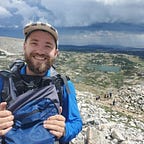Categorization isn’t Connection
How scientific naming gatekeeps everyday people from connecting with nature. And how to get around it.
Hiking down one of the quieter paths of Wissahickon Creek in Philadelphia, we come into a grove of tall, reaching trees, their crowns splayed open in mid-spring spearmint green. They command our attention.
A student points at one. “What kind of tree is that?” They ask.
“I don’t know,” I say, squinting. “Maybe a poplar.”
We stop and stare at the tree. I’m trying to identify it based on what I have learned in school: leaf arrangement, growth structure, bark pattern, crown shape. But I have no idea, and I feel like a total poser. Afterall, I’ve gone to school for this kind of thing, and I’ve been working outside all my life. Meanwhile, the tree itself has vanished. It has become another static object of my mind’s attention, a fixed, flaccid, thing of which I, the subject, try, and ultimately fail, to categorize.
Neither of us mention the tree again.
We are obsessed with learning the names that experts have assigned to things. It has become assumed that you need to know the name, Latin or laymen, of a plant or natural place to understand it — read its signs, experience its character, hear its voice. It’s as if you need a cell phone and a college degree to hear the blue-jays at the birdfeeder.
The obsession with species identification has stolen nature from our backyards and into the arcane towers of academia, accessible only to experts.
Thing is, categorization isn’t information in and of itself. Knowing which group a thing belongs to tells us nothing of the thing itself, as an individual: its physical character, apparent history, its proximity to other creatures, its struggles, its successes. Categorization by itself only breaks down or builds up my ego.
How do you form relationship with a creature without knowing its name?
Steps to Connection
In her book, “Writing Wild: Forming a Creative Partnership with Nature,” writer Tina Welling details three steps to connect with nature as writers, artists, and creative people.
Name — Describe — Experience
Naming things is a scientific and human necessity. It helps us uncover hidden connections between individuals, spot similarities, and identify differences. If I know this tree is an oak, I know that it produces acorns and tannins, anchors deep roots, blooms in late Spring, just as if you know your neighbor is from the same city as you, they know the same restaurants as you.
Description is attention in action. It is listening. Watching. Note-taking, mental or literal. It is in noticing the green, diamond-shaped lenticels through which the tree breathes on birch bark, and the low, lame limb that hangs from most pin oaks.
Experience is of the body. It is hugging the tree trunk. It is smelling the sap leaking out of a pine limb. Climbing a cottonwood liter. Putting your ear to its trunk and knocking on the wood. Even, unfortunately, smelling the sawdust after a tree has been cut.
You can experience and describe a plant, place, person, or other creature, before you know its name. Welling emphasizes this; you can start anywhere on that process you’d like, so long as you start. It’s like having a conversation: you can learn the other person’s name at the beginning or the end of your conversation. If you’re like me, you might never learn it all, addressing them only with “Hey!” And that’s okay.
Example.
“What kind of tree is that?” A student asks.
Instructor says, “A big one. It’s trunk is a little knobby and it has black bark that’s peeling. Kinda like dragon armor. What does it look like to you?”
The student looks at it. Shrugs. “Like salt and vinegar chips.”
Instructor thinks, Damn, you’re right.
Suddenly, the tree has come alive. All down its trunk are growing Lays salt and vinegar chips. You can almost taste them. It’s branches hang over the path like the arms of a lanky center in the NBA. It stands out against the background of grays, browns, blacks and silvers of the forest. The tree has become a subjective individual instead of a collected object.
Throughout the walk, you notice other trees with potato-chip bark. On one, you see small, black fruits hanging from them. The leaves, you notice, are alternatively arranged with small, egg-shaped leaves. You know that fruit…
A cherry! Of course. It’s a black cherry tree. When you leave the woods, you see cherry trees everywhere you go. With the name, description, and experience of the thing, it has become part of your subjective reality — a face with a name.
Categorization is not connection
It is a means to approach it.
Don’t know the name? Who cares. You know what it looks like. You can smell the bark. Chew (maybe) on the leaves. You can learn the leaf shapes and arrangements. You can recognize it based on association, metaphor. You don’t need a degree to know what’s in your backyard.
Remember Tina Welling’s three steps: description, name, experience. Start anywhere you’d like.
As Mary Oliver so famously put it, “To pay attention; this is our endless and proper work.”
